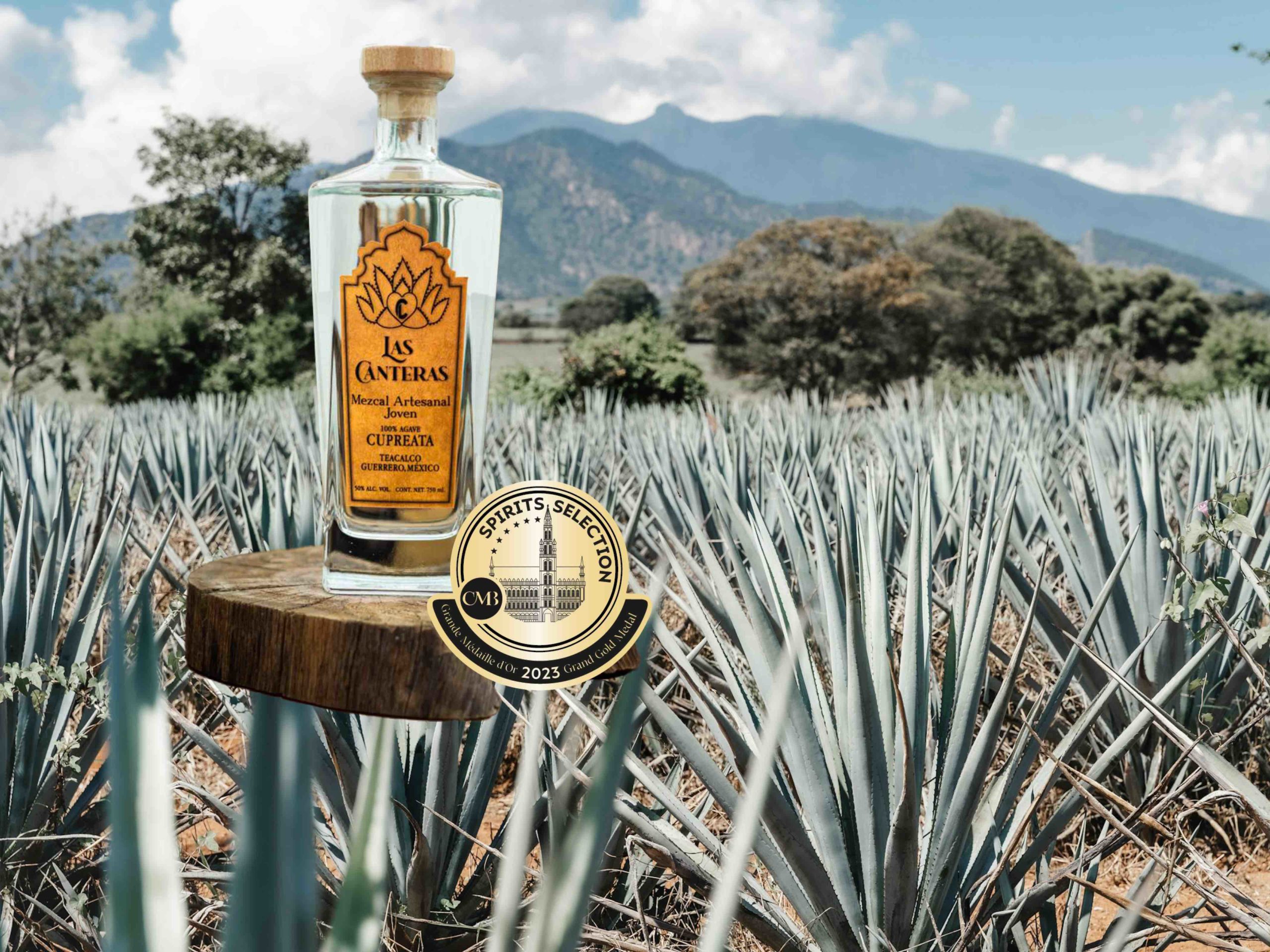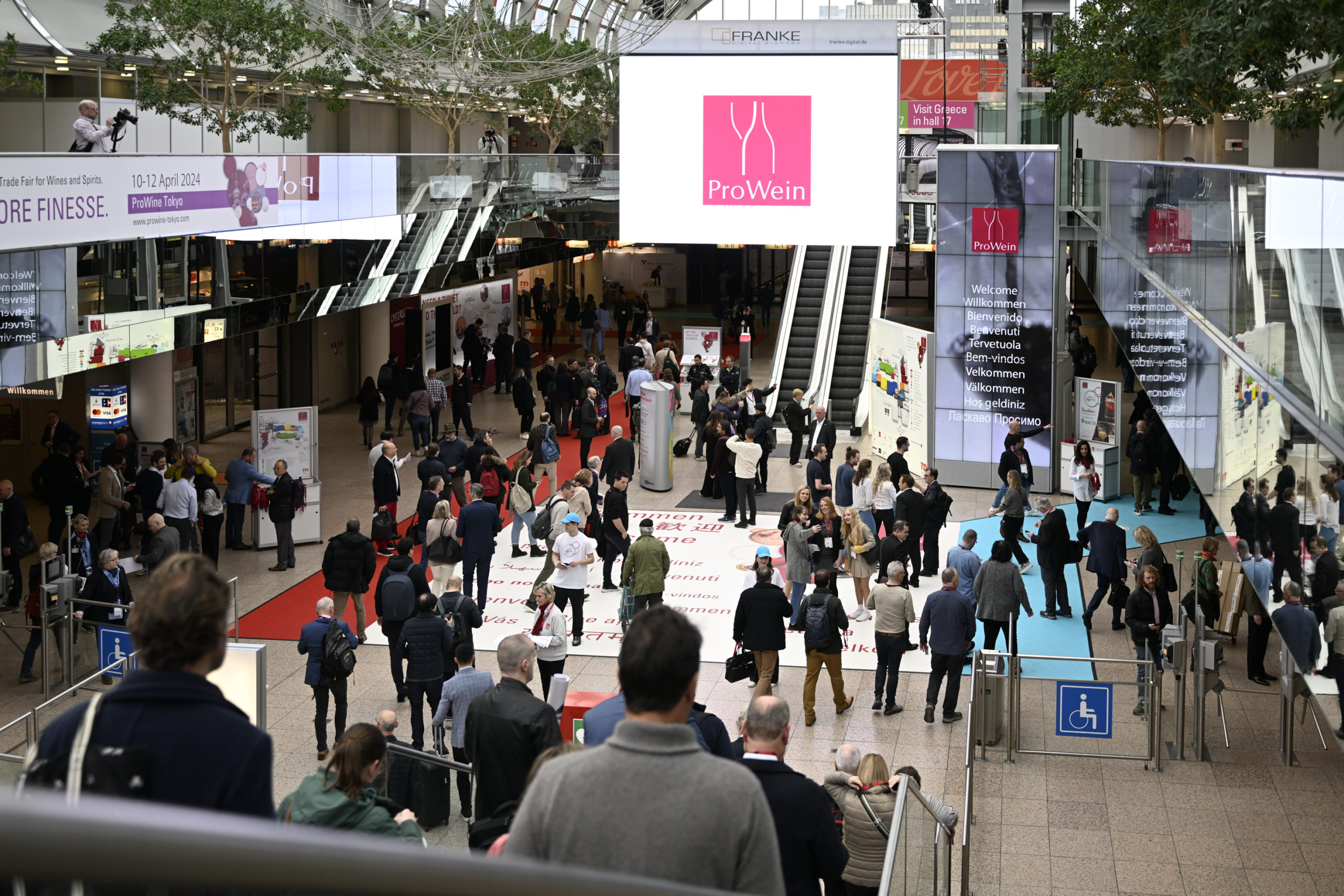The revival of fruit eaux-de-vie
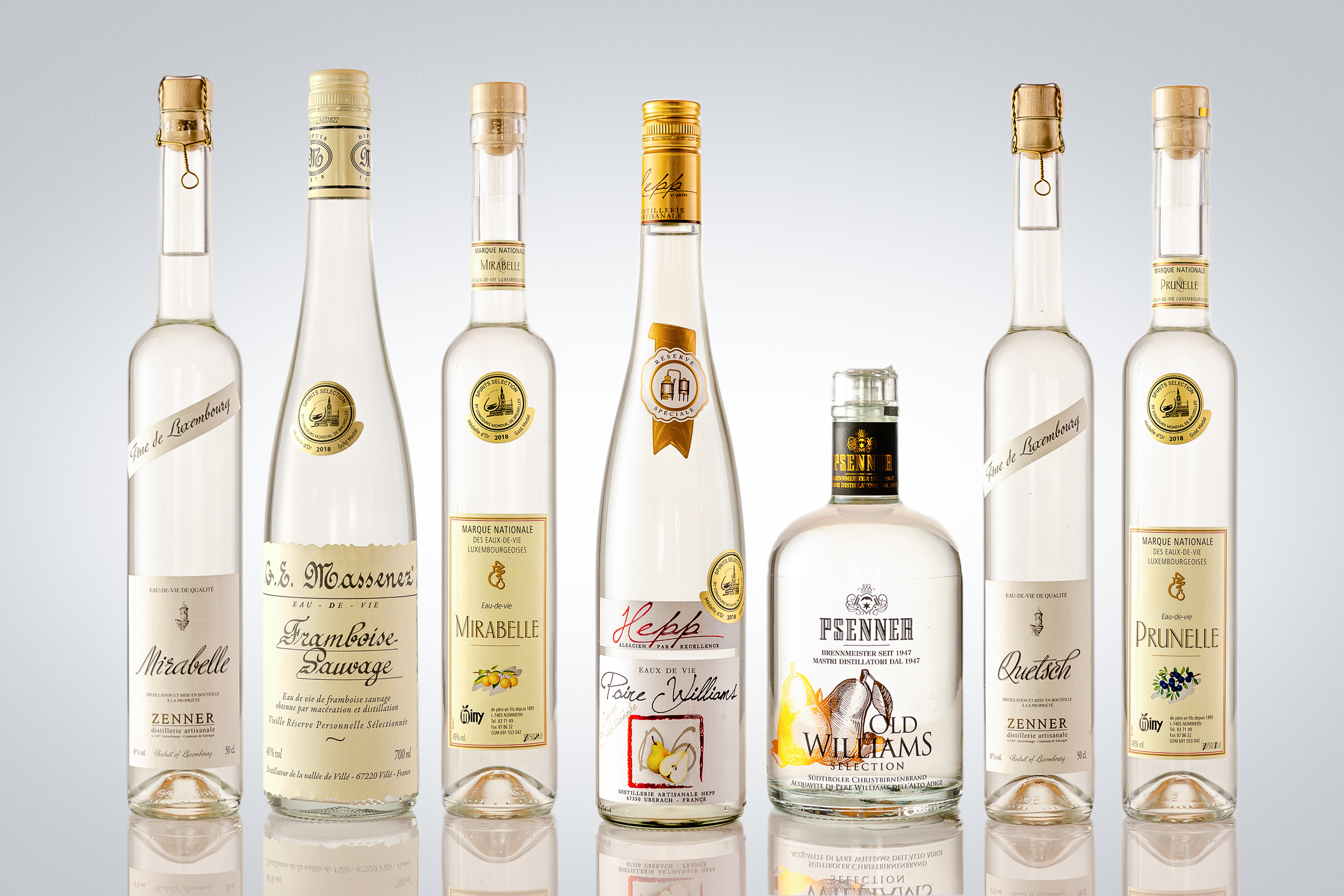
Fruit eaux-de-vie have long been produced in European countries, particularly in the so-called “fruit belt”, from Italy to Hungary, through France, Switzerland, Austria, Luxembourg, Germany, Serbia… not forgetting the Eastern countries. Distilling the fruits of the land has allowed us to preserve their aromas and bring back a summer vibe during the cold winter month.
By Thierry Heins, Cyril Mald and Ulric Nijs
Traditionally, these eaux-de-vie are drank as a digestif or, as in the Eastern countries, accompanying a meal. Unfortunately, these spirits have failed to capture a younger generation of drinkers, more attracted to products such as gin, rum, vodka, as well as cocktails. Whereas with the older populations, the consumption of digestives is in sharp decline. Thankfully there remain a core of real amateurs and dedicated producers to keep its rich tradition alive.
In today’s market, drinkers are no longer solely attracted to taste, but also to heritage; they want to know what they drink but also the origin of the product and its history…. In some ways, consumers are looking to reconnect with their roots. This trend has been ongoing over the past few years and, for the millennials, products that have a genuine heritage are products worthy of adoption.
Eaux-de-Vie have everything to meet these needs! There is a strong sense of provenance, heritage and terroir, furthermore they are often very qualitative and easy to appreciate. It is, however, at the level of positioning, communication and marketing that these eaux-de-vie must make an improvement in order the regenerate the category. It is not far-fetched to say that the European fruit biodiversity and many of passionate producers depend on it.
Maceration and fermentation
Fruit eaux-de-vie are obtained in two different ways: fermentation and maceration. Most fruits have enough sugar content to be directly fermented, others -mostly berries- must go through a process of maceration in neutral alcohol. There are, however, some of producers who manage ferment naturally some of the fruits that are more traditionally macerated -Windholtz ferments strawberry and raspberry, Rochelt and Zarić do Raspberry- but the quantities required of fruit required for such an achievement are enormous, to say the least.
Most of us do not quite understand the complexity of the various processes required to produce a quality eau-de-vie are. Indeed, it is a common misconception to think that it boils to simply harvesting the fallen fruits, storing them in small barrels and wait for the passage of the “brouilleur de cru” (traditional ambulant distiller). Living in the countryside, we are often offered small samples of these “artisanal” eaux-de-vie. They are often very “rustic” and completely forgettable! These “local” products often lend a negative image to the entire category. Eaux-de-vie are products where this idea that “artisanal” spirits are better than their industrial counterpart is completely misleading: To extract the soul from the fruit, one needs passion, “know-how” and, finally technology!

To extract the soul from the fruit, one needs passion, “know-how” and, finally technology!
A quality eau-de-vie needs a quality raw material; healthy fruits harvested at the right time. Damaged fruits are always discarded, the remaining fruits are properly cleaned -leaves and stalks are picked out as they give a pronounced bitterness to the final product. Some producers go a step further for their “cuvées” of exception and will go to great length to ensure that all fruits are peeled and thoroughly cored prior to fermentation and/or maceration.
After careful selection, the fruits are fermented in stainless steel vats over a period of 4 to 6 weeks under controlled temperatures. In some cases, yeast will be added to speed up the process; if the fermentation it is too slow, it will negatively affect the final product.
Once the fermentation is complete, the wort is carefully preserved awaiting distillation. The tanks are filled to the brim and properly seals to avoid oxidation and contact with external bacteria. Sometimes, the producers will go as far as freezing the wort with liquid nitrogen, allowing for a maximal freshness all the way to the distillation.
When fruits are macerated rather than fermented, they are kept in neutral spirit, in a closed environment and for a specific length of time. Fruit macerations tend to be more volatile and therefore brought for distillation much faster than its fermented counterpart. It is during this stage that eaux-de-vie differ from ” fruit spirits”; Indeed, less than 20kg of fruits macerated in 100 litres of neutral alcohol, and it can no longer be classified as an eau-de-vie, but rather as the more general term of “spirit”.
Distillation
Once the fruits are fermented or macerated, the fruit wort is ready to be distilled. The distillation usually takes place in Holstein or Carl stills, but sometimes, the traditional Burgundy still is used. What these stills have in common is the material; rich, beautiful and magical copper! Resistant to corrosion and neutral in taste, copper is a great heat conductor and acts as a catalyst for the chemical reactions during distillation. The distiller waits for the right moment to split the heads and tails of the distillate; both of which have a negative impact on the final flavours. All in all, two successive distillations are required, the “passe” and the “repasse”: The first distillation (the “brouillis”) will be at 30% ABV, but only the second distillation (68% to 72%) will yield a spirit with all the necessary qualities and elegance to be called an eau-de-vie.
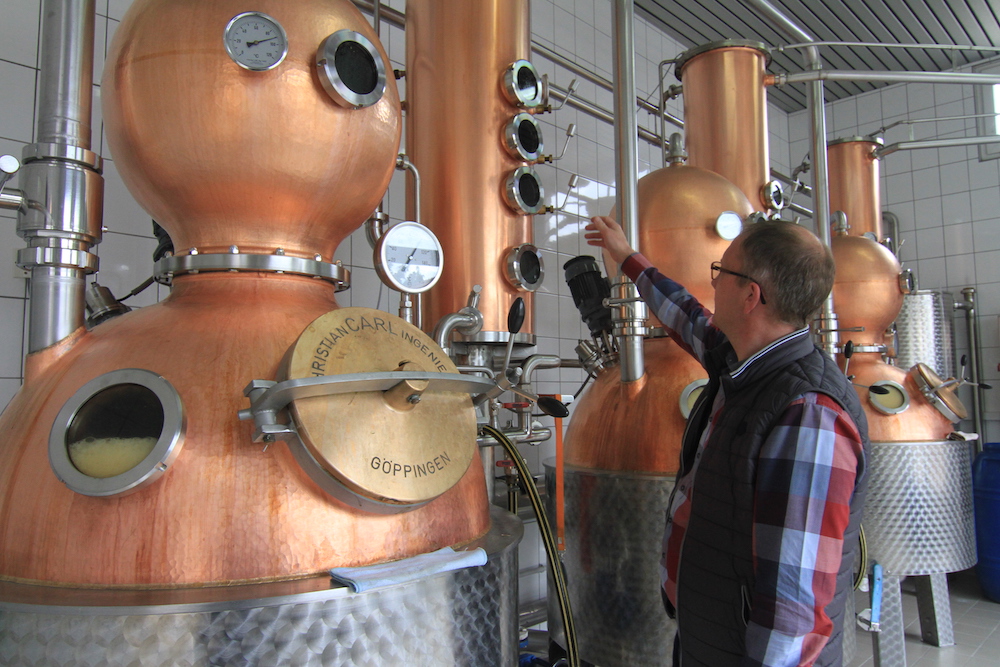
Picture : Distillerie Hepp – Alsace – France
Maturation
Freshly distilled eaux-de-vietend to be overly assertive and do not release their complete aromatic palette; it is necessary to allow them time to mature for at least 6 months and sometimes up to 3-15 years. This is usually done in stainless steel vats or in glass containers sealed with a tight filtering cloth: The alternating climate and temperature of the seasons accelerates the exchanges with air and humidity and are beneficial for a harmonious ageing of the liquid. For some fruits, the use of barrels is still frequent, such as with plum, as the fruit harmonises well with wood. However, most of eaux-de-vie are commercialized clear and unaged.

Freshly distilled eaux-de-vie tend to be overly assertive and do not release their complete aromatic palette; it is necessary to allow them time to mature for at least 6 months and sometimes up to 3-15 years.
Blending and Bottling
Eaux-de vie are then reduced to a commercial ABV with the addition of water. This process is done very slowly and while the spirit is continuously stirred, in order to avoid any loss of aroma. Any addition of water in the spirit will causes an exothermic reaction that can damage some of the more volatile aromas. Generally, eaux-de-vie they are bottled between 35 and 45%. However, some Alsace producers, such as Domaine Binner offer unreduced spirits.
“Selecting and blending eaux-de-vie brings an added value to the final product as you need to have the right nose to do it,” comments Emmanuel Hanquiez of the Manguin distillery in Provence. For this reason, there is generally no notion of age in eaux-de-vie.
Simple aromas
“The particularity of fruits eaux-de-vieis that they are trivial,” says Bernard Baud, President of the French Federation of fruit spirits, and General Manager of the Massenez-Peureux group. “The consumers must feel the same organoleptic characters as when they bite in the actual fruit. A pear eau-de-vie smells like a pear, tastes like a pear and some feel like a pear. We must find the aroma of the fruit in all its purity. The tasting lexicon of fruit eaux-de-vie is therefore quite simple. It is also the Achilles heel of the category. For example, the distillates that serve as the basis for most brandies and marc do not have enough aromas on their own, it is the time spent in barrels that will give them their aromatic bouquet, with a whole palette of aromas for which we have developed a complex vocabulary: Woody, spicy, rancio, vanilla notes etc.”

The consumers must feel the same organoleptic characters as when they bite in the actual fruit. A pear eau-de-vie smells like a pear.
The key aromas of these eaux-de-vie can have several origins. The primary aromas originate from the fruit, while the secondary aromas are formed during fermentation and the tertiary aromas during distillation.
“Some fruits have very strong primary aromas, which are not easily affected by either fermentation and distillation; such as Mirabelle plum but also the Williams pear -the most consumed fruit eau-de-vie in the world. At the opposite end of the spectrum, the primary aromas of cherries are extremely fragile and are totally degraded during fermentation and distillation. Kirsch does not taste of cherry, but instead develops aromas of kernel and almond, hence its popularity in the kitchen” he adds.
Macerated eaux-de-vie do not develop secondary and tertiary aromas, however they must be processed very quickly or develop mould and other undesirable traits. The raspberry for example, is a fruit known for its fragility, however when quickly and properly macerated and distilled, it boasts some of the most intense nose and aromas in the category
Repositioning of the product – marketing, mixology and innovations!
In countries that do not have any preconception of the product and where this old-fashioned “digestif” image is not so engrained, eaux-de-vie are very well accepted and respected; such as in Asia and particularly Japan.
“In Europe, outside the traditional production regions, we need to go through a process of consumer education,” commented Yannick Hepp of the eponymous distillery in Alsace. “We have a partner with whom we share a team of trained salesmen who cater to “cavistes”. It is a slow job and it takes a lot of effort.”
Some producers have dusted the image of their product by redesigning their bottles and labels. In many cases, it meant getting rid of the traditional high and slim bottles too reminiscent of the digestive of yesteryear, and replacing them with a contemporary look and feel, making them better adapted to the world of the modern bars. The range from the Manguin distillery in Provence is particularly successful, as are the liqueur manufacturers Joseph Cartron and Jacoulot in Burgundy. In Slovakia, Saint Nicolaus also updated their packaging of its Slovak Legend range; they now offer three eaux-de-vie -apricot, poire Williams and plum – in sleek bottles that are more frequently found in the world of gin and rum, with an updated communication designed to appeal to millennials: the safeguarding of trees in order to contributes to the preservation of biodiversity and of the environment.
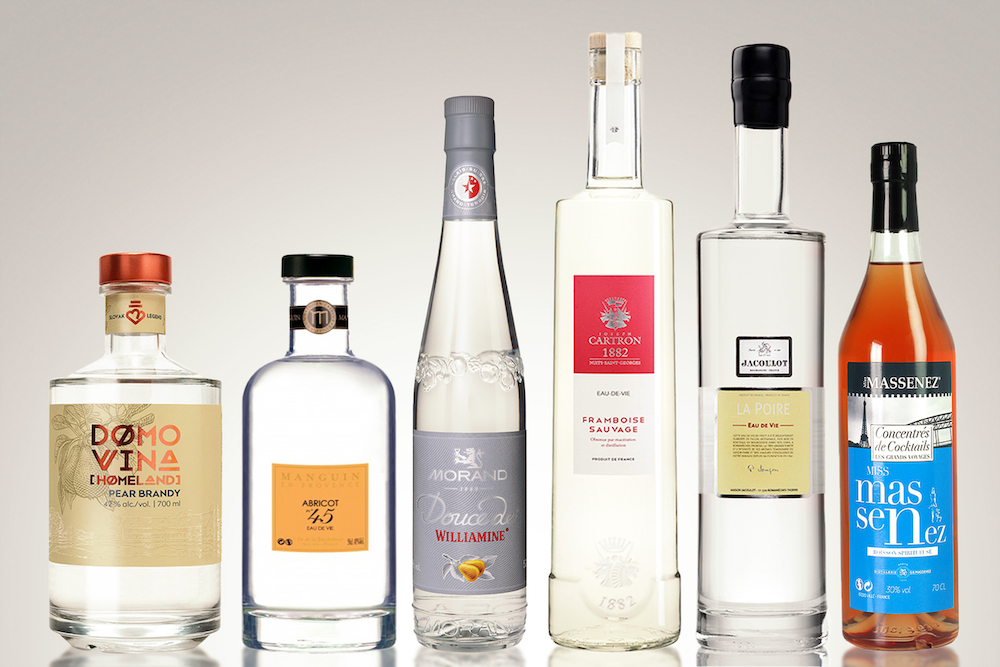
“To reinvigorate the category among younger people, we need first of all to propose qualitative products and to propose different uses,” commented Judith Cartron.
“While Japanese mixologists are quite fluent with using eaux-de-vie in cocktails, in Europe, bartenders are finding a reluctance from consumers when presented with a cocktail with poire Williams or kirsch,” adds Bernard baud. “At Massenez, we have created a new category called ” travel cocktail concentrates ” developed with mixologists; it is well received within the restaurant industry.”
Cartron and Jacoulot agree that the key lies in developing simple, but creative cocktails based on their eaux-de-vie and liqueurs and are working with several bartenders towards that goal.

To reinvigorate the category among younger people, we need first of all to propose qualitative products and to propose different uses.
Eaux-de-vie are luscious and -by definition- completely natural, but few are aware that is also a highly versatile category for either long drinks and/or cocktails: Indeed, a poire Williams & tonic requires the same work as a gin & tonic and is equally -if not more- satisfying! However, every producer we spoke to agree that it will require a great deal of time and efforts to communicate this properly and get consumer onto the band wagon!
On the other hand, almost every producer also shared their frustration at seeing bartenders persist in their adoption of flavoured vodkas rather than experimenting with eaux-de-vie. They benefit from a greater organoleptic character and are made with fresh agricultural products; two prerequisites for adoption by the modern mixologist.
Innovations are still scarce within the category but are always a resounding success for these who dare to push the limits while respecting their origins so as not to “bastardise” the category. Manguin offers a product called “Caraxès”, a blend of 80% poire Williams and 20% Bajan rum. It was an immediate success and has become their biggest selling product to date.
Morand is one of the best-known distilling families of the Canton du Valais in Switzerland; for them innovation and originality are part of their brand’s DNA. In 2007, they were among the first to develop a “soft” eau-de-vie to try to energize the category. The “soft” formula is a reinterpretation of traditional eaux-de-vie, with a reduced alcohol volume (30% instead of the more common 40 or 45%) and sweetened with approximately 100 grams of sugar per litres. The idea came from a popular ritual in Geneva: Le “moitié-moitié”, equal part eau-de-vie and corresponding liqueur. Illustrating that there was a demand for a softer alternative to the classic eau-de-vie, Morand simply had to bottle it. Julien Morand (4th generation) admits that the idea was difficult to sell to his father -a traditionalist- and that in some international markets, the “Douce De” range is sometimes a little difficult to sell as it straddles two worlds, Eau-de-vie and liqueurs.
Another innovation of Maison Morand is the formula “mousse” launched in 2017: These which a more playful side to their consumption. Mousse are Eaux-de-vie converted in foam, to be used in both mixology and culinary creations.
At this point, we should really tip our hat to the importance that eaux-de-vie in the world of spirits. Indeed, because they are the pure distillate of a fruit, they offer the cleanest possible translation of that fruit into the spirit lexicon. What could be better to illustrate the aroma of apricot than the distillate of apricot itself? Now, one is able to understand that aroma and identify it in whiskies, rums or even wines. As such, eaux-de-vie truly become the alphabet of wine and spirits comprehension. It is not surprising that many of the world’s best sommelier come from regions that are known to produce eaux-de-vie.
Tasting Notes
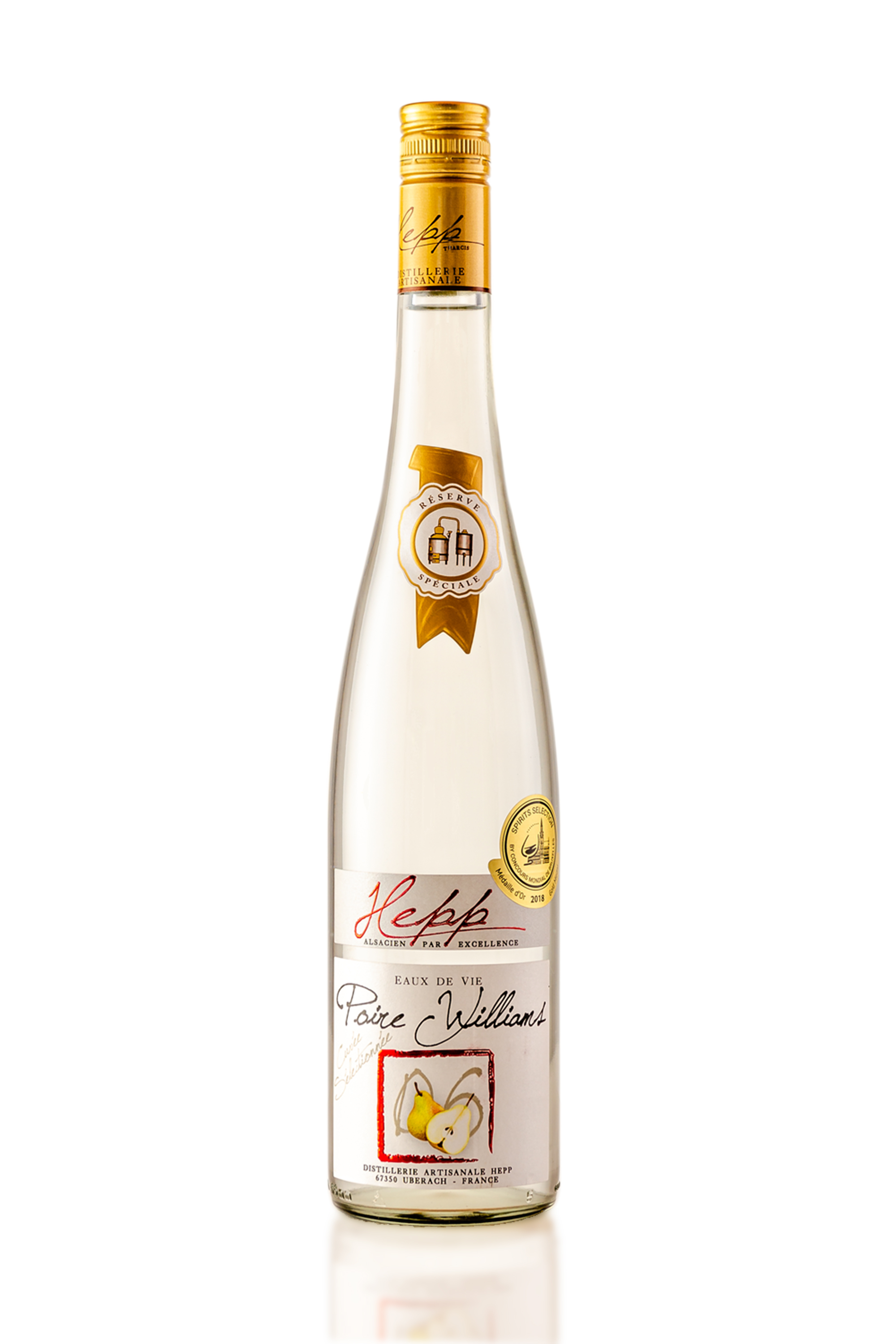 Poire William Selection – Distillerie Hepp, France – 42%
Poire William Selection – Distillerie Hepp, France – 42%
In order to deliver the aromatic power of this amazing poire Williams, the fruits are treated in a proprietary way (in itself, a well-kept family secret!) to allow to fruit to deliver every molecule of pure Willams aroma. So much that, when sipped one can feel the texture of the fruit itself.
Quintessential Apricot – Manguin en Provence, Manguin Distillery, France – 53.5%
Only the sweetest and most aromatic apricot from the Ventoux are selected and deliver an exceptionally fine and subtle eau-de-vie. 35kg of apricot are treated in a proprietary way for every litre of liquid, and they are rested in both stainless steel and glass before blended to perfection.
Douce De Williamine – Morand, Suisse – 30%
Made from an AOP controlled Williamine, this product bridges the gap between connoisseur and amateurs. The reduced alcohol allows the aromas of the pear to explode in the nose! Unlike a more classic poire Williams, Douce de Williamine tends to turn towards a more over-ripe pear, a little reminiscent of the Japanese Nashi pear.
Fermentation Raspberry-Zarić Distillery, Serbia – 40%
Serbia is one of the top three biggest exporters of raspberry in the world. The Kosjerić distillery offers a wide range of fruit brandies but none possesses the incredible aroma of this Raspberry. The nose is of absolute precision, going so far as to recreate the contours of the fruit. The mouth and the short finish are sumptuous and restore the aromatic strength of the fruit up to its slight sour note.
Wild Raspberry Brandy – Joseph Cartron, Burgundy, France – 45%
Purity, elegance and precision are the operative descriptors for this wild raspberry macerated eau-de-vie. Nothing disturbs the fruit aroma, it is beautifully well done, almost like a perfume! A real treat for the senses. Our “coup de Coeur”!
Eau-De-Vie De Coing – Artisanal Distillery Zenner, Luxembourg – 45%
A complex, elegant and discreet eau-de-vie, it is both floral and fruity with a discreet bouquet of dough or quince jelly.

Prunelle – Distillery Miny, Luxembourg – 45%
Amazingly powerful! The nose is smack full of tonka bean… In the mouth, it is powerful on a more tense profile, bitter almonds.

Cocktail Recipes

The Cartron spritz
10ml Wild Raspberry Brandy Joseph Cartron
25ml Joseph Cartron Cherry Cream
10ml Fresh Lemon Juice
100ml Crémant De Bourgogne
Pour all the ingredients into a wine balloon filled with ice cubes and mix gently with a spoon. Garnish with a fresh slice of lemon, fresh raspberries and cherries.
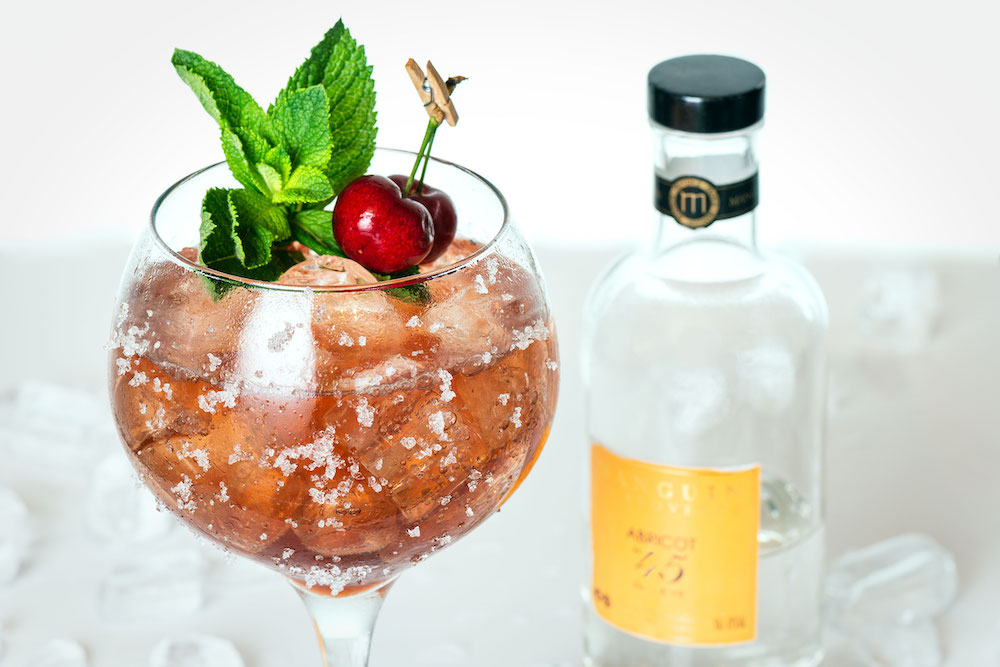
Abricollins by Lilian Sausset
50ml Apricot Eau-De-Vie Manguin
20ml Fresh Lemon Juice
15ml Crème De Cassis
Top with Tonic
Shake and strain into a wine balloon filled with cubed ice, top with tonic water and garnish with fresh mint and cherries.
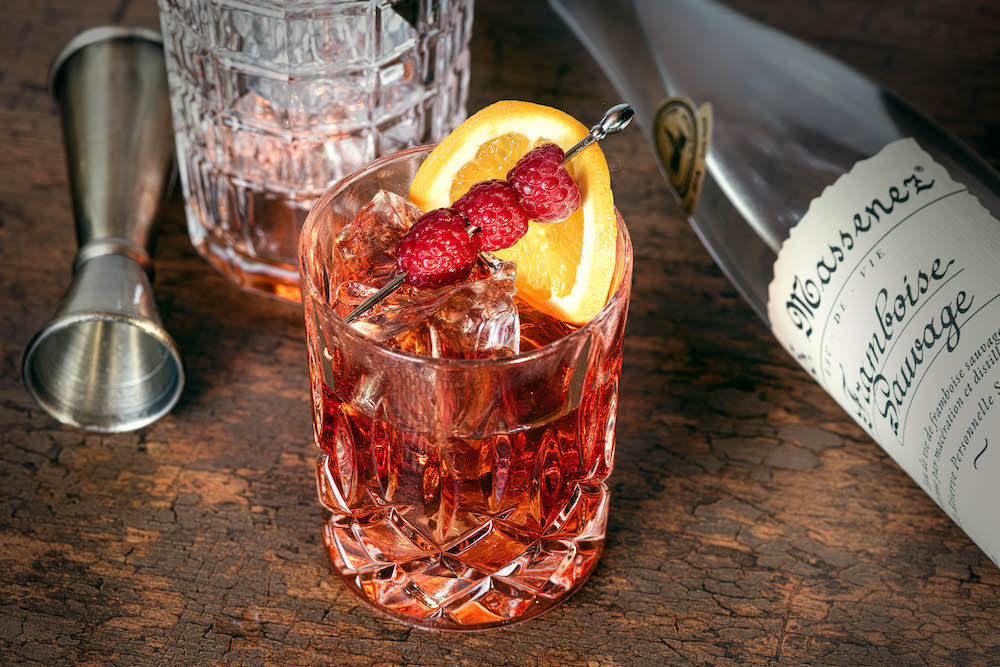 Eau Negroni
Eau Negroni
30ml Framboise Sauvage de Massenez
30ml Sweet Vermouth (Martini Rosso works well)
30ml Aperol.
Stir and strain into a double old-fashioned glass filled with cubed ice. Garnish with an orange slice + fresh raspberries.
Note: The Negroni is one of the most popular drink of the moment, and it goes INCREDIBLY well with eaux-de-vies! This variation is a fresh and vibrant alternative highlighting the versatility of Massenez Framboise Sauvage. Experiment! Is it too sweet with Aperol? I personally love it with Campari. You want to extract all that earthy flavor character of the Raspberry, Cynar is wonderful!

